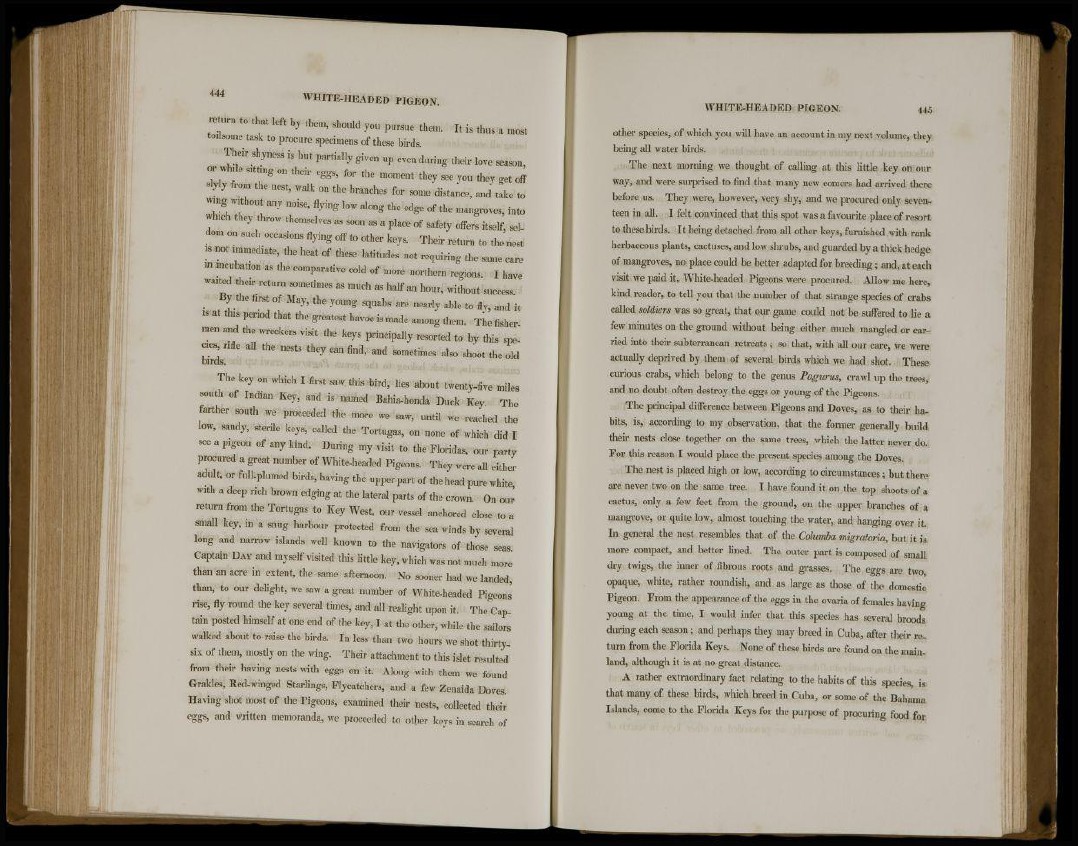
return to that left by them, should you pursue them. It is thus a most
toilsome task to procure specimens of these birds.
Their shyness is but partially given up even during their love season,
or while sitting on their eggs, for the moment they see you they get off
slyly from the nest, walk on the branches for some distance, and take to
wing without any noise, flying low along the edge of the mangroves, into
which they throw themselves as soon as a place of safety offers itself, seldom
on such occasions flying off to other keys. Their return to the nest
is not immediate, the heat of these latitudes not requiring the same care
in incubation as the comparative cold of more northern regions. I have
waited their return sometimes as much as half an hour, without success.
By the first of May, the young squabs are nearly able to fly, and it
is at this period that the greatest havoc is made among them. The fishermen
and the wreckers visit the keys principally resorted to by this species,
rifle all the nests they can find, and sometimes also shoot the old
birds.
The key on which I first saw this bird, lies about twenty-five miles
south of Indian Key, and is named Bahia-honda Duck Key. The
farther south we proceeded the more we saw, until we reached the
low, sandy, sterile keys, called the Tortugas, on none of which did I
see a pigeon of any kind. During my visit to the Floridas, our party
procured a great number of White-headed Pigeons. They were all either
adult, or full-plumed birds, having the upper part of the head pure white,
with a deep rich brown edging at the lateral parts of the crown. On our
return from the Tortugas to Key West, our vessel anchored close to a
small key, in a snug harbour protected from the sea winds by several
long and narrow islands well known to the navigators of those seas.
Captain D A Y and myself visited this little key, which was not much more
than an acre in extent, the same afternoon. No sooner had we landed,
than, to our delight, we saw a great number of White-headed Pigeons
rise, fly round the key several times, and all realight upon it. The Captain
posted himself at one end of the key, I at the other, while the sailors
walked about to raise the birds. In less than two hours we shot thirtysix
of them, mostly on the wing. Their attachment to this islet resulted
from their having nests with eggs on it. Along with them we found
Grakles, Red-winged Starlings, Flycatchers, and a few Zenaida Doves.
Having shot most of the Pigeons, examined their nests, collected their
eggs, and written memoranda, we proceeded to other keys in search of
WHITE-HEADED PIGEON. 445
other species, of which you will have an account in my next volume, they
being all water birds.
The next morning we thought of calling at this little key on our
way, and were surprised to find that many new comers had arrived there
before us. They were, however, very shy, and we procured only seventeen
in all. I felt convinced that this spot was a favourite place of resort
to these birds. It being detached from all other keys, furnished with rank
herbaceous plants, cactuses, and low shrubs, and guarded by a thick hedge
of mangroves, no place could be better adapted for breeding; and, at each
visit we paid it, White-headed Pigeons were procured. Allow me here,
kind reader, to tell you that the number of that strange species of crabs
called soldiers was so great, that our game could not be suffered to lie a
few minutes on the ground without being either much mangled or carried
into their subterranean retreats; so that, with all our care, we were
actually deprived by them of several birds which we had shot. These
curious crabs, which belong to the genus Pagicrus, crawl up the trees,
and no doubt often destroy the eggs or young of the Pigeons.
The principal difference between Pigeons and Doves, as to their habits,
is, according to my observation, that the former generally build
their nests close together on the same trees, which the latter never do.
For this reason I would place the present species among the Doves.
The nest is placed high or low, according to circumstances; but there
are never two on the same tree. I have found it on the top shoots of a
cactus, only a few feet from the ground, on the upper branches of a
mangrove, or quite low, almost touching the water, and hanging over it.
In general the nest resembles that of the Columba rnigratoria, but it is
more compact, and better lined. The outer part is composed of small
dry twigs, the inner of fibrous roots and grasses. The eggs are two,
opaque, white, rather roundish, and as large as those of the domestic
Pigeon. From the appearance of the eggs in the ovaria of females having
young at the time, I would infer that this species has several broods
during each season; and perhaps they may breed in Cuba, after their return
from the Florida Keys. None of these birds are found on the mainland,
although it is at no great distance.
A rather extraordinary fact relating to the habits of this species, is
that many of these birds, which breed in Cuba, or some of the Bahama
Islands, come to the Florida Keys for the purpose of procuring food for